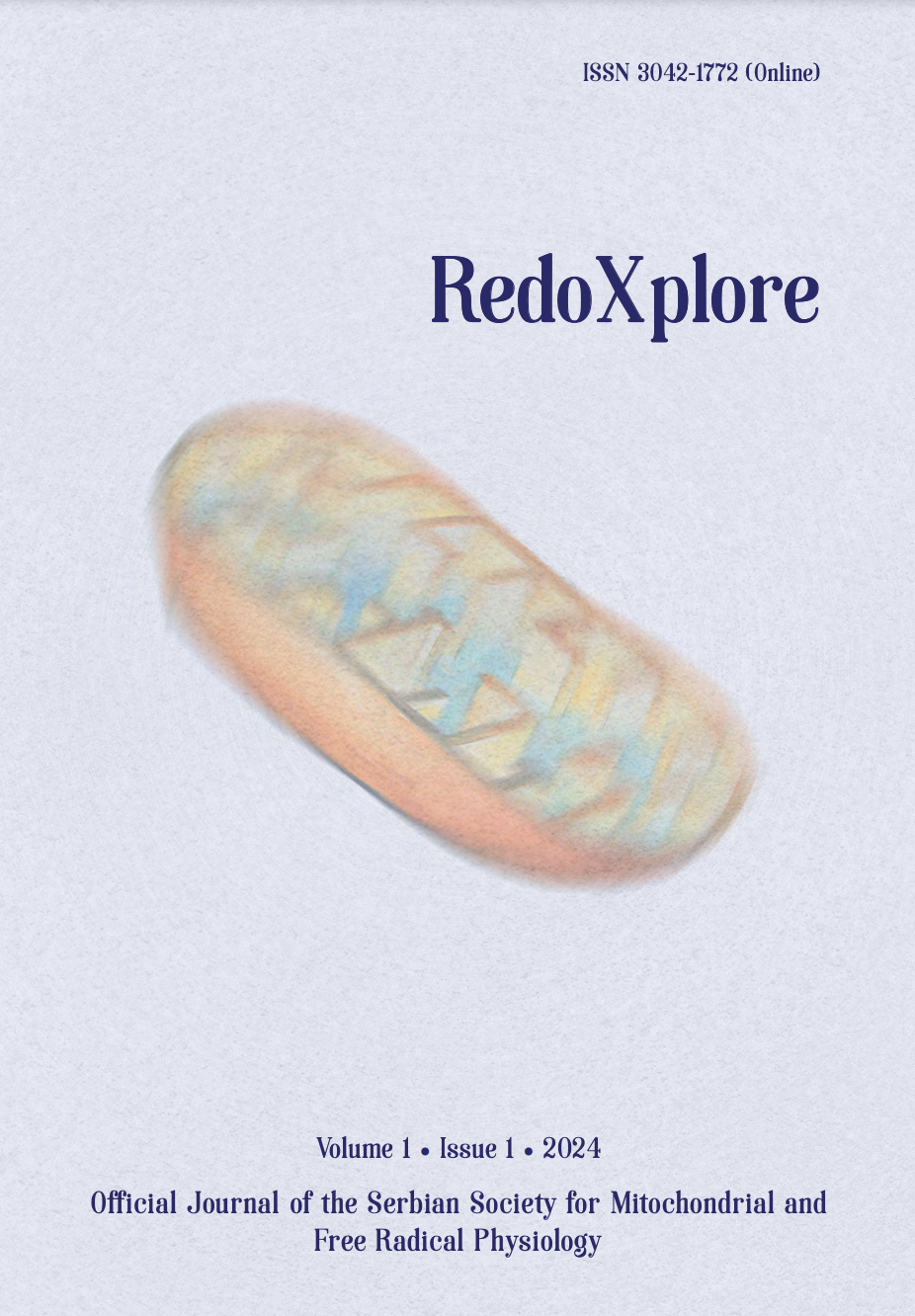
More articles from Volume 1, Issue 1, 2024
REDOX AND METABOLIC REPROGRAMMING OF BREAST CANCER CELLS AND ASSOCIATED ADIPOSE TISSUE - THE CORNERSTONES OF ADAPTIVE TUMOUR BEHAVIOUR
INSULIN MODULATES MITOCHONDRIAL STRUCTURAL AND FUNCTIONAL MOSAICISM IN BROWN ADIPOCYTES
NITRITE MITIGATES OXIDATIVE BURST IN ISCHEMIA/REPERFUSION IN BRAIN SLICES
NITRIC OXIDE, SUPEROXIDE AND PEROXYNITRITE – REDOX REGULATION OF THE CARDIOVASCULAR SYSTEM BY NITRO-OXIDATIVE STRESS AND S-NITROS(YL)ATION
DIETARY NITRATE AS PIVOT ON THE GUT MICROBIOTA-HOST REDOX COMMUNICATION
EFFECTS OF ARTIFICIAL LIGHT ON OXIDATIVE STRESS PARAMETERS IN AMPHIBIANS: A CASE STUDY OF HYLA ARBOREA
Department of Physiology, Institute for Biological Research “Siniša Stanković” – National Institute of Republic of Serbia, University of Belgrade , Belgrade , Serbia
Department of Physiology, Institute for Biological Research “Siniša Stanković” – National Institute of Republic of Serbia, University of Belgrade , Belgrade , Serbia
Department of Physiology, Institute for Biological Research “Siniša Stanković” – National Institute of Republic of Serbia, University of Belgrade , Belgrade , Serbia
Department of Physiology, Institute for Biological Research “Siniša Stanković” – National Institute of Republic of Serbia, University of Belgrade , Belgrade , Serbia
Department of Physiology, Institute for Biological Research “Siniša Stanković” – National Institute of Republic of Serbia, University of Belgrade , Belgrade , Serbia
Department of Evolutionary Biology, Institute for Biological Research “Siniša Stanković” – National Institute of Republic of Serbia, University of Belgrade , Belgrade , Serbia
Department of Evolutionary Biology, Institute for Biological Research “Siniša Stanković” – National Institute of Republic of Serbia, University of Belgrade , Belgrade , Serbia
Department of Evolutionary Biology, Institute for Biological Research “Siniša Stanković” – National Institute of Republic of Serbia, University of Belgrade , Belgrade , Serbia
Faculty of Biology, University of Belgrade , Belgrade , Serbia
Department of Evolutionary Biology, Institute for Biological Research “Siniša Stanković” – National Institute of Republic of Serbia, University of Belgrade , Belgrade , Serbia
Department of Physiology, Institute for Biological Research “Siniša Stanković” – National Institute of Republic of Serbia, University of Belgrade , Belgrade , Serbia
Editor: Bato Korac
Published: 29.08.2024.
Short oral presentations
Volume 1, Issue 1 (2024)
Abstract
Human activity and rapid urbanization created disturbance factors that drastically changed natural habitats. The introduction of artificial light at night changed natural light-dark regimes affecting a range of biological processes. Disruption of circadian rhythm is linked with changes in endocrine and neurobiological systems that control hormonal regulation, food intake, metabolism, reproduction, and behavior of animals. Oxidative stress was suggested as a possible mechanism through which artificial light could affect an organism’s physiology and health. We examined the oxidative status of tree frog (Hyla arborea) under two artificial night light intensities 20 lux and 90 lux. Artificial light affects the antioxidant system of both larval and juvenile stages. Larvae had higher activity for glutathione peroxidase only for 90 lux, while greater lipid damage was observed in individuals under both light regimes compared to control. Juvenile individuals showed boosted antioxidant response seen through higher activities of superoxide dismutase, catalase, and glutathione peroxidase. Finally, development under artificial light led to higher levels of protein damage in juveniles. Artificial light at night acts primarily through direct effects and can persist across life stages. Overall results point out that exposure to artificial light alters physiological traits in amphibians, such as oxidative status that could have various consequences on individuals in natural populations.
Citation
Copyright

This work is licensed under a Creative Commons Attribution-NonCommercial-ShareAlike 4.0 International License.
Article metrics
The statements, opinions and data contained in the journal are solely those of the individual authors and contributors and not of the publisher and the editor(s). We stay neutral with regard to jurisdictional claims in published maps and institutional affiliations.






